Methods of identification of psychological parameters of a human person in a context of analytical physiognomy are described on the first page in this website section, namely asymmetric features of a face correspond to activity and passivity of mental functions, and symmetric features of a face correspond to obvious and unobvious mental functions that determines psychological types. But actually human faces are complex objects of observation as features are mobile, namely can change appearance according to displays of those or other psychological types, and also features of a human face are subject to emotional movements. And consequently it is necessary to correlate features to psychological parameters correctly, and in essence it is necessary to take into account methodical subtleties of visual identification of human faces.
|
Aristotle.
|
For example, in sculptural image of Aristotle it is
possible to see: - the left and right eyebrows are symmetric but as a whole eyebrows have a tone and are raised, that corresponds to obvious ethical function and unobvious logic function; - the left eye has the big sizes in comparison with the right eye that corresponds to active extraversion; - the left corner of a mouth is a little raised in comparison with the right corner of a mouth that corresponds to active sensory function and passive intuitive function. Asymmetry of mouth's corners is insignificant, but nevertheless it is possible to see that the left corner of a mouth has a greater tone rather than the right corner of a mouth. It is possible to assert that 36th explicit psychological type of analytical physiognomy is represented in sculpture of Aristotle. This type can be shown as sensory-ethical extraverted EFSP. |
Plato.
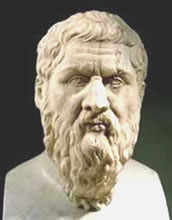


 in
aggregate 33th
in
aggregate 33th
In sculptural image of Plato at the left it is possible to see:
- the left and right eyebrows are symmetric, but as a whole eyebrows have a weak
tone that corresponds to obvious logic function and unobvious ethical function;
- the right eye and the left eye are symmetric, but as a whole the sizes of eyes
are small that corresponds to obvious introversion;
- the left corner of a mouth has a greater tone in comparison with the right
corner of a mouth that corresponds to active sensory function and passive
intuitive function.
Features of the face in sculptural image of Plato at the right are similar to
sculptural image at the left but there is one difference, namely the right
corner of a mouth has the greater tone in comparison with the left corner of a
mouth that corresponds to active intuitive function and passive sensory
function.
It is possible to count that in the left sculpture there is 13th explicit
psychological type which can be shown as sensory-logic introverted ITSP, and in
the right sculpture there is 44th explicit psychological type which can be shown
as intuitive-logic introverted ITNP. But it is possible to assume that Plato
could smile both corners of a mouth equally, and in this case two sculptural
images in aggregate correspond to 33th harmonious psychological type of
analytical physiognomy. Namely it is possible to assume that the shown
sculptures represent the face of Plato and in particular represent a mouth in
movement, but the mouth was symmetric in a quiet condition, and as a whole the
face of Plato corresponded to harmonious psychological type of analytical
physiognomy. As harmonious types can be shown according to different mental
functions and consequently Plato smiled or did emotional movements by the left
corner of a mouth when he was shown as sensory-logic type. Or smiled by the
right corner of a mouth when he was shown as intuitive-logic type.
It is necessary to notice that eyebrows are motionless in the shown sculptures
that is a physiognomic attribute of explicit psychological types which have
emotional mobility of any one features of a face, and other features remain
motionless. Namely if any one corner of a mouth is mobile only, and accordingly
irrational mental function sensory or intuition is conducting, then eyebrows
should be motionless. And if the right eyebrow only or the left eyebrow only is
mobile, and accordingly any rational mental function logic or ethics is
conducting, then the mouth should be motionless. In this case the psychological
type can be identified as explicit but if it is possible to see movements of
several features of a face then it is necessary to correlate psychological type
to a class of harmonious or contrast types. Namely in sculptural images of Plato
it is possible to see motionless eyebrows, but also it is possible to see
movements of both corners of a mouth and consequently the type is harmonious. If
only any one corner of a mouth had mobility then it would be possible to
identify type as obvious, but nevertheless mobility of both corners of a mouth
specifies harmonious type not looking that eyebrows are motionless.
In total harmonious types can have bilateral mobility of eyebrows and corners of
a mouth, either differently only eyebrows or only corners of a mouth can be
mobile. But in any case if both eyebrows are mobile or both corners of a mouth
are mobile, and also features of a face are symmetric in a quiet condition, then
the psychological type of analytical physiognomy is harmonious.
Contrast psychological types have unilateral mobility of eyebrows and corners of
a mouth, namely if any one eyebrow is mobile but the second eyebrow is
motionless, and if any one corner of a mouth is mobile but other corner of a
mouth is motionless then it is possible to identify psychological type as
contrast.

 |
For example, in the photo of writer Jack London it is
possible to see: - the right eyebrow has a greater tone in comparison with the left eyebrow that corresponds to active logic function and passive ethical function; - the left eye is more than the right eye that corresponds to active extraversion; - the right corner of a mouth has a greater tone in comparison with the left corner of a mouth that corresponds to active intuitive function and passive sensory function. It is possible to identify 18th contrast psychological type of analytical physiognomy. This type can be shown as logic-intuitive extraverted ETNJ or as intuitive-logic extraverted ETNP. |
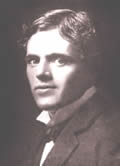 |
In other photo of Jack London it is possible to see that the left corner of a mouth has a greater tone in comparison with the right corner of a mouth that corresponds to active sensory function and is caused by emotional movement. Namely in this case person of Jack London is shown as logic-sensory type, that is not peculiar for contrast psychological types which have no bilateral mobility of facial features and consequently it is possible to admit that motionless eyebrows and bilateral mobility of the mouth specify harmonious psychological type. But harmonious types have symmetric features of a face in a quiet condition, but the photo of Jack London has more active right eyebrow and passive left eyebrow, and also have a big activity of the right corner of a mouth that corresponds to contrast psychological type of analytical physiognomy. Hence, during visual identification it is necessary to take into account that contrast psychological types can have bilateral mobility of facial features in some cases. |
Besides it is necessary to consider prevailing displays of base psychological types of Brigs Majers Indicator and socionics in contrast psychological types of analytical physiognomy.


 |
For example, in two photos of singer Kylie Minogue it
is possible to see: - the right eyebrow has a greater tone in comparison with the left eyebrow that corresponds to active logic function and passive ethical function; - the right eye is more than the left eye that corresponds to active introversion; - the left corner of a mouth has a greater tone in comparison with the right corner of a mouth that corresponds to active sensory function and passive intuitive function. |
It is possible to identify 21st contrast psychological type of analytical physiognomy. This type can be shown as logic-sensory introverted ITSJ or as sensory-logic introverted ITSP. Display of logic-sensory introverted type prevails in person of Kylie Minogue according to the left photo, as the right eyebrow is more active rather than the left corner of a mouth, and display of sensory-logic introverted type prevails according to the right photo, as the left corner of a mouth is more active rather than the right eyebrow that is caused by emotional movement of the left corner of a mouth.
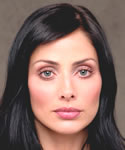
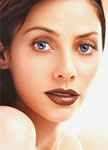
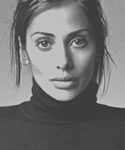

In photos of singer Natalie Imbruglia it is possible to see:
- the right eyebrow has a greater tone in comparison with the left
eyebrow that corresponds to active logic function and passive ethical function;
-the right eye and the left eye are symmetric in the left photo, but the right
eye is more than the left eye in other photos that corresponds to active
introversion;
- the right corner of a mouth has a greater tone in comparison with the left
corner of a mouth that corresponds to active intuitive function and passive
sensory function.
It is possible to identify 64th contrast psychological type of analytical
physiognomy. This type can be shown as logic-intuitive introverted ITNJ or as
intuitive-logic introverted ITNP, but it is impossible to see bigger activity of
the right eyebrow or the right corner of a mouth and consequently it is
impossible to identify a prevalence of this or that type. And it can be seen in
photos made in different time that speaks about constant in time characteristics
of the person.
Symmetric features of a face and obvious mental functions have advantage
above asymmetric features and active mental functions, though C. G. Jung
considered differently that active mental functions have a greater advantage.
But as a matter of fact features of a face can change from asymmetric in
symmetric or from symmetric in asymmetric during life that is caused by
progressive or regressive development of human soul.
It is impossible to speak about positive or negative properties of symmetry or
asymmetry of a human face as progressive or regressive development of human soul
can be necessary or required.
The following page also shows examples of visual identification of harmonious, contrast, explicit psychological types of analytical physiognomy.